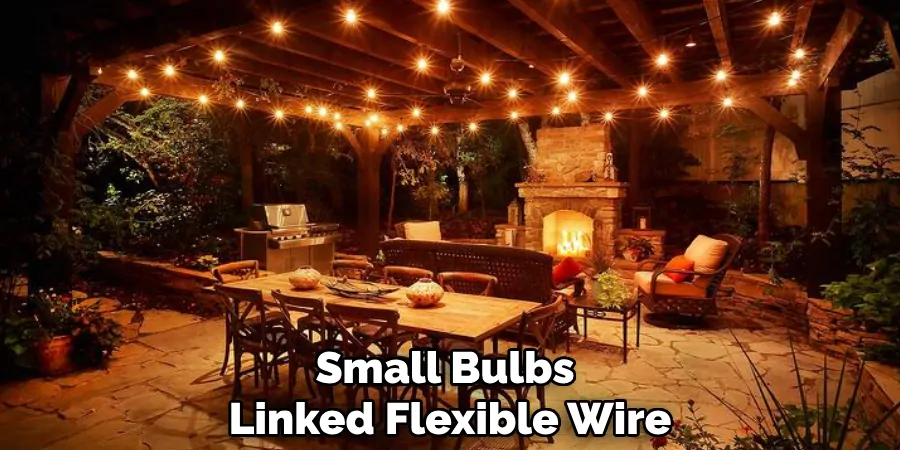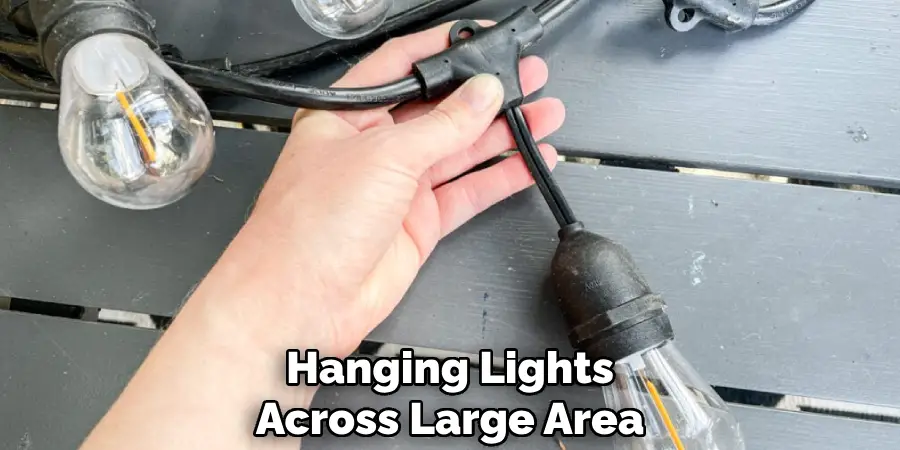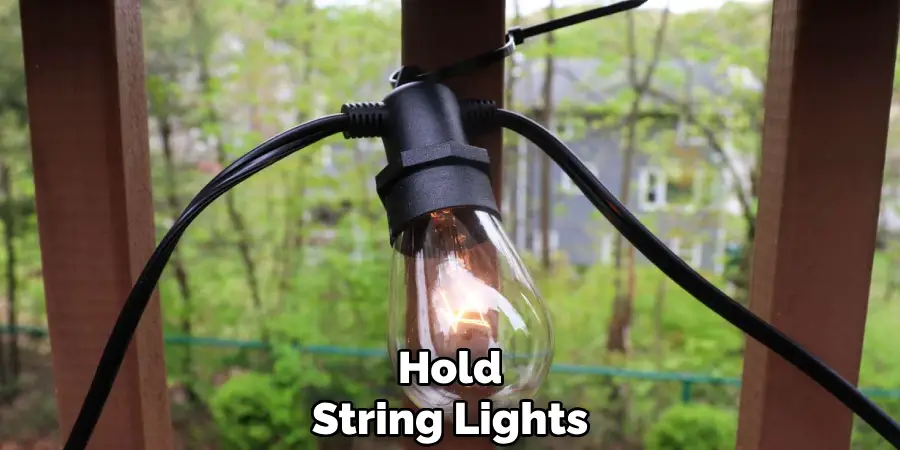Transforming your outdoor space into a cozy, inviting retreat is easily achieved with the addition of café lights. Perfect for patios, these lights cast a warm, ambient glow, making any evening feel magical. Whether you’re planning a lively barbecue or a quiet, restful night under the stars, café lights can set the perfect mood.
Hanging these lights may seem daunting at first, but with a simple approach and the right tools, you can turn your patio into a charming oasis for entertaining or relaxation. In the following steps, we’ll guide you through the process of how to hang cafe lights on patio, ensuring a secure and aesthetically pleasing setup.

Importance of Patio Lighting
Patio lighting plays a crucial role in enhancing both the functionality and ambiance of outdoor spaces. Not only does it extend the usability of your patio well into the evening hours, allowing for late-night conversations and alfresco dining, but it also adds an essential layer of safety. Well-placed lights can illuminate pathways and steps, reducing the risk of accidents.
Beyond practicality, thoughtful lighting creates a welcoming atmosphere, transforming an ordinary patio into an enchanting escape. Additionally, effective use of lighting can highlight landscape features, architectural elements, and decorative accents, elevating the aesthetic appeal of your outdoor area.
Types of Cafe Lights
When choosing cafe lights for your patio, there are several styles and options to consider, each delivering a distinct vibe and functionality. String lights are perhaps the most popular choice, featuring small bulbs linked along a flexible wire, easy to drape across spaces. For a vintage and rustic appeal, Edison bulbs with visible filaments offer a classic touch with their warm, inviting glow. Globe lights, which come in a variety of sizes, provide a more uniform light distribution, perfect for creating a festive atmosphere.
If energy efficiency and durability are key considerations, LED string lights are an excellent choice, offering bright, consistent light while consuming less power. Additionally, for those desiring flexibility in design, color-changing lights can transform the mood at the touch of a button with adjustable hues and intensities, making them ideal for various occasions. Each type of light brings a unique character to your patio, allowing you to customize the ambiance to suit your specific taste and style.

10 Methods How to Hang Cafe Lights on Patio
1. Planning Your Layout
Before you start hanging your café lights, it’s crucial to plan the layout. Consider the overall design you want, whether it’s a simple zigzag, a crisscross pattern, or draped lines. Measure the area where you intend to hang the lights, taking into account the length of the string lights and the distance between any anchor points.
This step will help you avoid surprises later on, such as running out of lights or overextending them. Visualize the layout and decide whether you want the lights to cover the entire patio or just a portion of it. Planning ahead saves time and ensures that the final result aligns with your vision.
2. Choosing the Right Café Lights
Not all café lights are created equal, so it’s essential to choose the right ones for your space. Outdoor string lights come in a variety of styles, bulb shapes, and colors. Consider whether you want LED bulbs for energy efficiency and longevity, or incandescent bulbs for a warmer glow. Make sure the lights you choose are specifically rated for outdoor use, as they are designed to withstand weather conditions such as rain and wind. Café lights with shatterproof bulbs are ideal if you live in an area prone to strong winds or if the lights are in a high-traffic area. By choosing the right lights, you ensure both functionality and aesthetics.
3. Gathering the Necessary Tools and Supplies
To hang your café lights effectively, gather the necessary tools and supplies. You will need a ladder, measuring tape, hooks or screw eyes, zip ties, and possibly extension cords. If you’re hanging lights across a large area, you may also need sturdy poles or wooden posts to support them. For added safety, a voltage tester can help ensure that the power source is functioning correctly. Having all your materials on hand before starting the project ensures a smoother installation process and prevents unnecessary delays.

4. Deciding on Anchor Points
Anchor points are critical for supporting the weight of the café lights and keeping them securely in place. These points could be walls, trees, fences, or posts that are already part of your patio setup. If you don’t have existing structures to use as anchors, consider installing poles or hooks specifically for the lights.
Make sure the anchor points are sturdy and well-positioned according to your layout. Ideally, the anchor points should be spread evenly to avoid sagging and ensure the lights are taut. Having secure anchor points is essential for safety and ensuring the longevity of your lighting setup.
5. Installing Hooks or Screw Eyes
Once you’ve determined your anchor points, install hooks or screw eyes into the walls, trees, or posts. These hooks will hold the string lights in place. If you’re attaching them to a wooden surface, drill pilot holes to prevent the wood from splitting, then screw in the hooks or screw eyes securely.
For brick or stone surfaces, use masonry anchors and screws for a secure hold. Space the hooks according to your design plan, ensuring they are positioned at the right height to create the desired draping effect. Installing these hooks ensures that your café lights are firmly anchored and ready for hanging.

6. Hanging the Lights
With the hooks or anchors in place, it’s time to hang the lights. Start by attaching one end of the lights to the first anchor point, ensuring the string is secure. Work your way around the patio, attaching the lights to each subsequent anchor point according to your layout plan.
Use zip ties or clips to fasten the lights to the hooks, making sure they are evenly spaced and taut between each point. As you go, periodically step back to check the alignment and make any necessary adjustments. Hanging the lights carefully ensures a clean, professional appearance and prevents the lights from sagging or tangling.
7. Adjusting for Tension and Height
Once the café lights are in place, check the tension along the entire length of the string. You want the lights to be taut but not overly tight, as some draping adds to the aesthetic appeal.
If the lights are hanging too low or sagging, adjust the tension by tightening the zip ties or repositioning the hooks. If you need to raise the height of the lights, adjust the anchor points accordingly. Balancing the tension and height gives the lights a polished look and ensures they don’t obstruct walkways or seating areas.
8. Connecting to a Power Source
After the lights are hung, it’s time to connect them to a power source. Use an outdoor-rated extension cord if the lights don’t reach the outlet. Make sure the outlet is properly grounded and equipped with a weatherproof cover. Plug the lights in and check that they are all working. If you have multiple strands of lights, connect them according to the manufacturer’s instructions, ensuring you don’t exceed the maximum wattage limit for the outlet or the string lights themselves. Properly connecting the lights to a power source ensures they function safely and reliably.

9. Securing Loose Wires and Cords
To create a tidy, safe environment, it’s important to secure any loose wires or cords. Use zip ties or cord clips to fasten any dangling wires along the edges of walls, posts, or fences. If you’re using an extension cord, make sure it’s tucked away to prevent tripping hazards. You can also hide extension cords by running them along the base of the patio or covering them with outdoor rugs. Securing loose wires not only enhances the appearance of your setup but also ensures that the patio remains a safe space for walking and seating.
10. Testing and Final Adjustments
Once everything is in place and connected, turn on the café lights to test the setup. Walk around the patio and check for any bulbs that may not be working or any sections that need adjustment. If you notice that any lights are too dim or flickering, check the connections and replace any faulty bulbs. Step back and assess the overall aesthetic—make any final adjustments to the draping, height, or tension to ensure the lights are hanging as intended. Testing and final adjustments ensure that your patio lighting is functional, safe, and beautifully aligned.
Conclusion
Installing café lights on your patio can transform the space into a welcoming oasis, perfect for entertaining or relaxing under the stars. By planning your layout, gathering the necessary tools, and following each step carefully, you can achieve a professional and aesthetically pleasing installation. Thanks for reading, and we hope this has given you some inspiration on how to hang cafe lights on patio!

